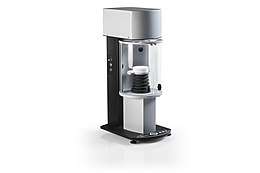Du Noüy ring method
The du Noüy ring method is a technique for measuring the surface tension of a liquid. The method involves slowly lifting a ring, often made of platinum, from the surface of a liquid. The force, , required to raise the ring from the liquid's surface is measured and related to the liquid's surface tension, :

where is the radius of the inner ring of the liquid film pulled and is the radius of the outer ring of the liquid film.[1] is the weight of the ring minus the buoyant force due to the part of the ring below the liquid surface.[2]
When the ring's thickness is much smaller than its diameter, this equation can be simplified to:
where R is the average of the inner and outer radius of the ring.[2]
This technique was proposed by the French physicist Pierre Lecomte du Noüy (1883–1947) in a paper published in 1925.[3]

The measurement is performed with a force tensiometer, which typically uses an electrobalance to measure the excess force caused by the liquid being pulled up and automatically calculates and displays the surface tension corresponding to the force. Earlier, torsion wire balances were commonly used. The maximum force is used for the calculations, and empirically determined correction factors are required to remove the effect caused by the finite diameter of the ring:
with f being the correction factor.
The most common correction factors include those by Zuidema and Waters (for liquids with low interfacial tension), Huh and Mason (which covers a wider range than Zuidema-Waters), and Harkins and Jordan (more precise than Huh-Mason while still covering the most widely used liquids).[4]
See also

References
- Butt, Hans-Jürgen; Graf, Karlheinz; Kappl, Michael (2003). "Physics and Chemistry of Interfaces": 14–15. Cite journal requires
|journal=(help) - Lyklema, J. (2000-07-10). Fundamentals of Interface and Colloid Science: Liquid-Fluid Interfaces. Elsevier. ISBN 9780080507132.
- du Noüy, Pierre Lecomte (1925). "An Interfacial Tensiometer for Universal Use". The Journal of General Physiology. 7 (5): 625–633. doi:10.1085/jgp.7.5.625. PMC 2140742. PMID 19872165.
- Udeagbara, Stephen Gekwu (2010-07-30). Effect of Temperature and Impurities on Surface Tension of Crude Oil. Universal-Publishers. ISBN 9781599423555.
External links
| Wikimedia Commons has media related to Du Noüy ring method. |